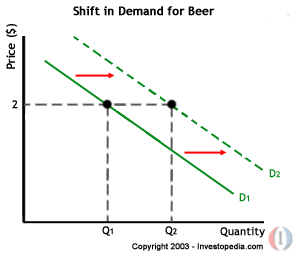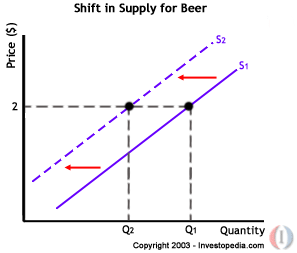A movement refers to a change along a curve. On the demand curve, a movement denotes a change in both price and quantity demanded from one point to another on the curve. In other words, a movement occurs when a change in the quantity demanded is caused only by a change in price, and vice versa.
 |
Like a movement along the demand curve, a movement along the supply curve means that the supply relationship remains consistent. In other words, a movement occurs when a change in quantity supplied is caused only by a change in price, and vice versa.
 |
Shifts
A shift in a demand or supply curve occurs when a good's quantity demanded or supplied changes even though price remains the same.
 |
If the price for a bottle of beer was $2 and the quantity supplied decreased from Q1 to Q2, then there would be a shift in the supply of beer. Like a shift in the demand curve, a shift in the supply curve implies that the original supply curve has changed, meaning that the quantity supplied is effected by a factor other than price. A shift in the supply curve would occur if, for instance, a natural disaster caused a mass shortage of hops; beer manufacturers would be forced to supply less beer for the same price.
 Factors that affect DEMAND: 1) A rise in incomes. As incomes increase, peoples purchasing power increases and this leads to an increase in Demand. Example: People will buy their own private cars instead of using public transportation. 2) Changes in population. The greater the population, the greater the Demand. 3) Expectation of consumersAbout future prices Example: If the price of iphone is going to increase the demand for it now will increase, and vice versa. About future availability. If people expect that in the future there will be a shortage in the supply of tissue paper, they will keep a stock. Therefore,demand increases. About future income. If you expect a raise in your income, your demand will increase and vice versa. Factors that affect SUPPLY: 1) Cost of production As the cost of production increases, the supply will decrease. Possible causes of an increase in the cost of production: -rise in wagse -rise in the cost of raw materials -increase in the expenditure taxes 2) The state of technology As technology advances, productivity increases and therefore supply increases. 3) Changes in prices of substitute goods. Example: If a farmer plnats more than one product (broccoli and corn) and he notices that prices of corn are increasing in the economy while those of broccoli are decreasing he would increase the supply of corn and decrease that of broccoli. (AND vice versa) 4) Government regulations. If the government decides to increase subsidies, the supply will increase. |

No comments:
Post a Comment